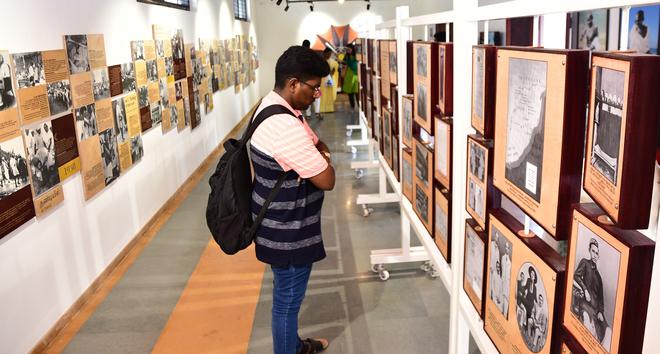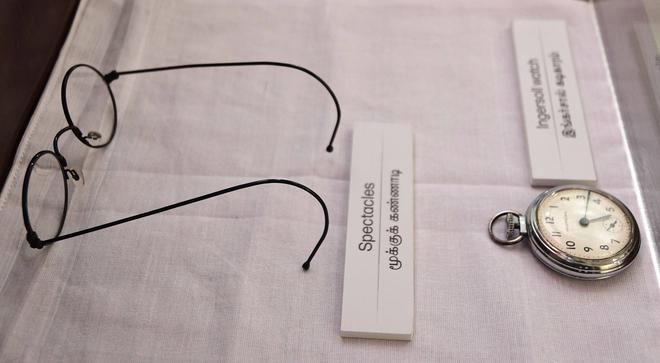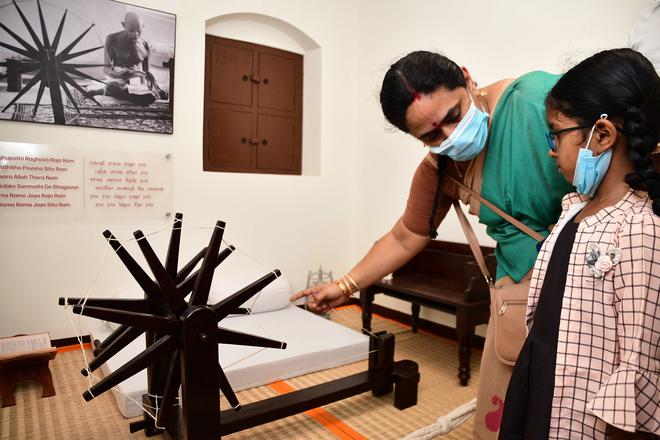Gandhiji had had a long day. He was on the Coimbatore leg of his journey in the Madras Presidency, collecting funds for his Harijan Welfare organisation. It was 11pm by the time he arrived at the guest house at Podanur, a suburb in Coimbatore. But he was not ready to retire for the night; not when he had accounting work to do — funds collected in Coimbatore were one-fourth of the entire amount collected in the presidency. It was 2am by the time he went to bed, and he was up at 4am.
This was on February 6, 1934.
Eighty-eight years later, I walk into the same house, and stand at the entrance of the tiny room where Gandhi did his accounting. A lantern sits in a corner, near a low table. A white mattress is spread along a wall, and a charkha stands in front of it. Dusk has just passed and in the brief moment when traffic slows down and silence fills the air, I feel the weight of the moment.
The house has been open for public viewing from October 2. Anything could have happened to it over the years following Gandhi’s visit: it could have been demolished or changed beyond recognition. But it has survived, giving people a chance to recall the life and times of a man who visited it.

The house belongs to the family of inventor and entrepreneur GD Naidu, known for his contributions to engineering. It has now been restored as the Mahatma Gandhi Memorial House, featuring a photo gallery, library, semi-open conference space, and displays of replicas of artefacts used by Gandhi, such as his spectacles, Ingersoll watch, rosary, and the charkha.

The tile-roofed structure sports a thinnai (front courtyard); on the walls inside, are photos with descriptions on the importance of GD House and events that transpired during Gandhi’s visit, such as the laying of the foundation stone for Sri Ramakrishna Vidyalaya. ‘The GD Naidu bungalow was occupied by the Vidyalaya,’ reads a display. On the morning of February 7, he laid the foundation stone in front of the house, after students sang a prayer song.
A small library is coming up inside an adjacent room and at a building nearby, a photo gallery takes viewers through the life story of Gandhi. There are photos of letters he wrote to important people, such as Tagore; a note in his well-known simple handwriting; there even is a copy of his Matriculation exam results from 1887.

GD House, a few years ago, was in fact overgrown with weeds, with nothing but a marble statue of Gandhi in the front. “I happened to drive past it one day,” recalls BK Krishnaraj Vanavarayar, the chairman of the Kumaraguru Institutions group in the city. Curious, he hopped off his car and was trying to see what was inside. “An elderly gentleman, dressed in khadi, approached me, saying that the house belonged to GD Naidu’s family, and that Gandhi had stayed there,” says Krishnaraj. “He told me to speak to the family and see if something can be done to restore it.”
Soon, Krishnaraj reached out to GD Gopal, Naidu’s son, and things picked up speed. The pandemic slowed things down, but the house has had its dream opening, with the architects who worked on its renovation, keeping the original architecture intact.
According to Shankar Vanavarayar, Krishnaraj’s son and the president of Kumaraguru Institutions, GD House is probably the only existing structure in Tamil Nadu in which Gandhi stayed during his visit to the State. He envisions the Memorial as an “active centre”, one which will drive the thought of leadership among people by involving organisations working with youngsters and educational institutions.
As for the elderly man who started this all, Krishnaraj does not remember his name. He probably walked in on October 2, the inauguration day, with a cloth bag slung across his shoulder, and sat on the thinnai Gandhi slept, on the night of February 6, 1934.







